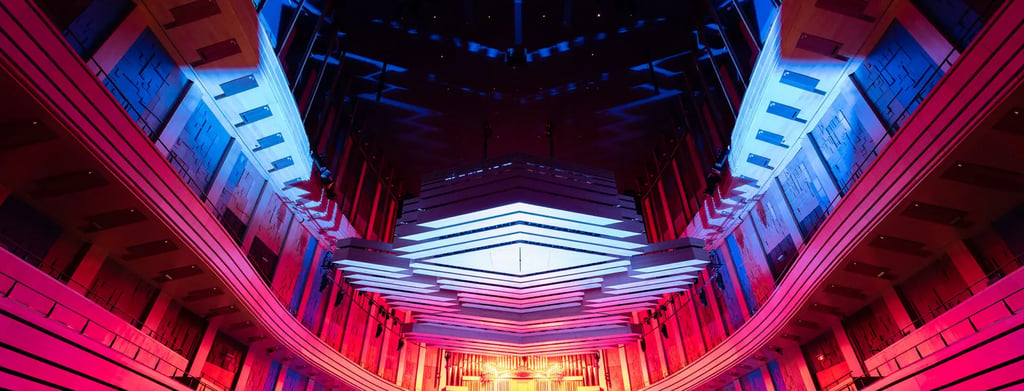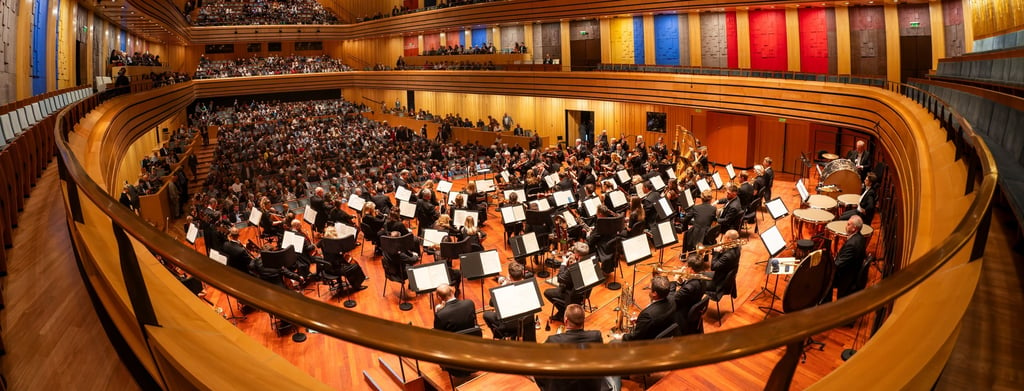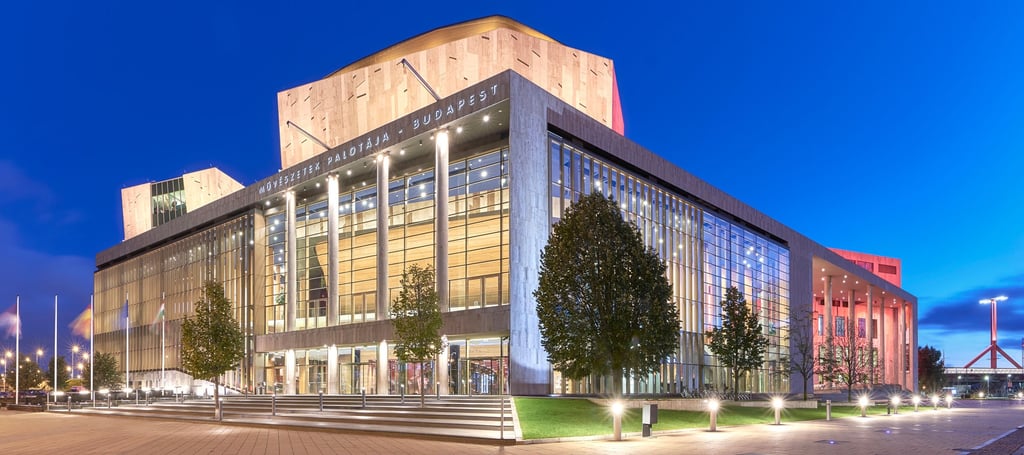Müpa Budapest – Palace of Arts: Where Architecture Sings and Culture Dances
Step into a sanctuary where music breathes, light dances, and every corridor hums with the rhythm of creativity.


A Vision Realized: The Birth of Müpa Budapest
In the heart of Budapest, along the serene banks of the Danube, stands Müpa Budapest—formerly known as the Palace of Arts—a testament to Hungary's dedication to the arts. Conceived in the early 2000s, this cultural haven was envisioned as a space where various art forms could coexist, inspire, and flourish. The architectural brilliance of Gábor Zoboki and his team brought this vision to life, culminating in the grand opening of Müpa in March 2005. theatre-architecture.eu+1Wikipedia+1
Müpa Budapest was not merely constructed; it was orchestrated—each element meticulously designed to harmonize with the next, creating an environment where art is not just displayed but experienced.
Architectural Symphony: Design and Structure
The architecture of Müpa Budapest is a harmonious blend of modern design and functional artistry. The building's façade, adorned with expansive glass panels, invites natural light to flood the interiors, creating a dynamic interplay between the inside and the outside world. The use of natural materials, such as wood and stone, adds warmth and texture, grounding the contemporary design in timeless elegance.
Inside, the spatial organization is intuitive, guiding visitors through a journey of artistic exploration. The building houses three main venues: the Béla Bartók National Concert Hall, the Festival Theatre, and the Ludwig Museum. Each space is designed with acoustical and visual precision, ensuring that every performance, exhibition, or event is delivered with the utmost clarity and impact. webpaket+6bachtrack.com+6en.funiq.hu+6
Béla Bartók National Concert Hall: An Acoustic Masterpiece
At the heart of Müpa Budapest lies the Béla Bartók National Concert Hall, renowned for its exceptional acoustics and architectural grandeur. Designed to accommodate 1,699 guests, the hall features a horseshoe-shaped auditorium with three tiers of balconies, creating an intimate yet expansive setting. Müpa+12Operabase+12bachtrack.com+12Wikipedia
The hall's acoustics were meticulously engineered by the late Russell Johnson, a world-renowned acoustician. Innovative features, such as a 42-ton movable acoustic canopy and adjustable wall panels, allow for the fine-tuning of sound, catering to a diverse range of musical performances. The centerpiece of the hall is its grand organ, one of the largest in Europe, boasting 92 stops and over 6,000 pipes. bachtrack.comen.funiq.huWikipedia
Festival Theatre: A Stage for Diverse Performances
Adjacent to the concert hall is the Festival Theatre, a versatile venue designed to host a variety of performances, including theatre productions, dance performances, and chamber music concerts. With a seating capacity of 452, the theatre offers an intimate atmosphere, allowing audiences to connect closely with the performers. The stage is equipped with state-of-the-art technology, including a movable orchestra pit and advanced lighting systems, enabling seamless transitions between different types of performances. bachtrack.com
Ludwig Museum: A Contemporary Art Haven
Müpa Budapest is also home to the Ludwig Museum, Hungary's premier institution for contemporary art. The museum showcases an extensive collection of modern artworks, featuring both Hungarian and international artists. Exhibitions span various mediums, including painting, sculpture, photography, and multimedia installations, offering visitors a comprehensive view of contemporary artistic expressions.
The museum's design complements its exhibits, with spacious galleries, high ceilings, and natural lighting creating an inviting environment for art appreciation. Interactive installations and educational programs further enhance the visitor experience, fostering a deeper understanding of contemporary art.
Cultural Programs and Festivals
Müpa Budapest is not only a venue but also a vibrant cultural hub, hosting a myriad of programs and festivals throughout the year. Signature events include the Budapest Wagner Days, a festival dedicated to the works of Richard Wagner, and the Liszt Fest, celebrating the legacy of Franz Liszt. Other recurring programs encompass jazz concerts, contemporary dance performances, and film screenings, catering to a wide array of artistic tastes. Müpa
These events position Müpa Budapest as a dynamic platform for both established and emerging artists, fostering cultural exchange and artistic innovation.Müpa
Visitor Amenities and Services
To enhance the visitor experience, Müpa Budapest offers a range of amenities, including the P’Art Café and Bistro, where guests can enjoy refreshments in a relaxed setting. The Vince Bookstore provides a selection of art-related publications, while the Hangfürt CD Shop offers a curated collection of music recordings. Müpa
Additionally, the venue is equipped with facilities to accommodate visitors with disabilities, ensuring accessibility for all guests. Guided tours are available, providing insights into the architectural and artistic aspects of the building.


A Home for All Disciplines
What sets Müpa Budapest apart is its interdisciplinary spirit. Unlike institutions that confine themselves to a singular form, Müpa embraces multiplicity—classical and contemporary, Hungarian and international, acoustic and digital. This is not a house with one voice, but a choir of cultural languages, singing in unison across halls, walls, and genres.
Here, it is not unusual to see a Wagner opera followed by a Japanese Butoh performance, or a Béla Bartók symphony giving way to an electronic improvisation. One evening might offer a Franz Liszt piano recital, the next a screening of a silent film accompanied by live jazz. Müpa is not only a space for the arts—it is a laboratory for artistic encounter, where boundaries melt and curiosity reigns.
The Organ of Organs: A Mechanical Giant
The concert hall organ, affectionately referred to as the “queen of instruments,” is a marvel unto itself. Commissioned specially for Müpa, it took seven years to complete, bringing together the expertise of Hungarian and German craftsmen. With 92 stops, five manuals, and over 6,800 pipes, this instrument can replicate the subtleties of a flute or unleash the thunder of an orchestra on its own.
It’s not merely for show. The organ is regularly used in concerts, recitals, and festivals. International virtuosos come to Budapest to play it, and when they do, the building seems to inhale and exhale with their every phrase. Few experiences compare to the way the hall vibrates with low frequencies or lifts with shimmering crescendos from this magnificent machine.
The Acoustics: Hearing in Color
Much praise has been given to Müpa’s acoustical precision, and for good reason. Russell Johnson, the world-renowned acoustician who consulted on the project, was known for his obsessive attention to detail. Every inch of wood, every curve of the wall, every panel was designed to respond to sound—to embrace it, amplify it, never distort it.
The result is a hall where every whisper is clear, every note rounded. No amplification is needed for orchestras or chamber ensembles. The space amplifies without falsifying. Musicians describe it as playing inside a finely tuned instrument; audiences describe it as hearing music for the first time.
Events for All Ages
Müpa Budapest places a strong emphasis on education and accessibility. Programs for children and youth are central to its mission, including:
Interactive concerts for families
Music education workshops
School outreach programs
Art and music summer camps
Puppet shows and storytelling performances
These aren’t simplified versions of the real thing—they’re tailored introductions into the world of creativity, fostering a love for performance, listening, and participation from a young age.
Adults, too, benefit from talks, lectures, masterclasses, and artist meet-and-greets, often tied to the program calendar. Müpa doesn’t just show art—it teaches how to think with it, about it, through it.


Visiting Information
Location
Müpa Budapest – Palace of Arts
Komor Marcell u. 1, 1095 Budapest, Hungary
Located along the Danube in the cultural district of Pest, next to the National Theatre and near Rákóczi Bridge.
The venue is easily accessible by public transportation:
Tram 2 (Müpa–Nemzeti Színház stop)
HÉV suburban railway (Boráros tér)
Numerous buses and taxis
Parking is available in the underground garage, with electric vehicle charging stations.
Opening Hours
Ticket Office: Tuesday–Sunday, 10:00 AM – 6:00 PM or until the start of the last performance
Closed on Mondays (except during performances)
The building is open daily from 8:00 AM to 11:00 PM for café, bookstore, and exhibitions.
Ticket Prices
Tickets vary based on performance and seating, but here are general ranges:
Classical concert: 2,500–16,000 HUF (approx. $7–$45)
Jazz and world music: 2,000–8,000 HUF (approx. $5.50–$23)
Theatre or dance performance: 3,000–12,000 HUF (approx. $8.50–$34)
Children’s programs: 1,000–3,000 HUF (approx. $3–$8.50)
Seasonal passes, student discounts, and Müpa+ membership benefits are available.
Accessibility
Müpa Budapest is fully accessible to individuals with disabilities:
Elevators and ramps throughout
Wheelchair seating available
Free admission for registered assistants
Audio description and sign-language interpretation at select events
Official Website and Social Media
Stay updated on upcoming events, purchase tickets, or explore past performances:
Website: https://mupa.hu/en
Facebook: https://www.facebook.com/mupabudapest
Instagram: https://www.instagram.com/mupabudapest








